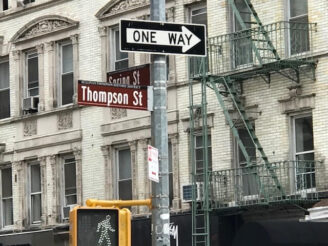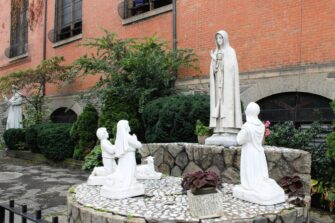Sullivan-Thompson Historic District Personal Injury Lawyer

The Sullivan-Thompson Historic District of Lower Manhattan is distinguished due to its layered history as a residential and commercial district.
A close look at the district reveals various building styles. Clean lines and flat roofs distinguish Italianate tenement buildings. Neo-Grec buildings are easy to spot: Intricate cresting reminiscent of Greek columns adorns the edges of the roofs. Queen Anne-style tenement buildings have elegant molding over arched windows and imposing cresting.
These brownstone-faced buildings don’t scrape the sky or gleam with glass, but since the turn of the 20th century, they have housed boutiques and small shops. These former tenement buildings of amber, cream and brown are the hallmark of the neighborhood.
Key Features of the Area
Table of Contents
The Sullivan-Thompson Historic District was not only designated for its aesthetic value and intrigue, both of which are considerable, but also for its cultural significance. The Sullivan-Thompson Historic District was an enclave for many immigrants, primarily Italian Americans.
 The Italian influence on the area is reflected in the magnificent Church of Saint Anthony of Padua at 155 Sullivan Street. The pale stonework is anchored by a massive round stained-glass window. Since its construction in 1888, it has welcomed countless worshippers and has served as a reminder of the powerful ways in which immigrants have shaped the nation.
The Italian influence on the area is reflected in the magnificent Church of Saint Anthony of Padua at 155 Sullivan Street. The pale stonework is anchored by a massive round stained-glass window. Since its construction in 1888, it has welcomed countless worshippers and has served as a reminder of the powerful ways in which immigrants have shaped the nation.
In the 1850s, construction followed a rise in immigration: Residential, single-row houses cropped up in the district. As the influx of immigrants strengthened, tenement buildings sprouted. These tenement buildings are the defining feature of the district.
As you tour the Sullivan-Thompson Historic District, the vibrant Vesuvio Playground breaks up the array of brownstones. The Vesuvio playground on Thompson Street is a modern addition to the neighborhood, but it too owes its name to Italian Americans. Anthony Dapolito was a community leader and prominent businessman who played a significant role in developing open spaces in the Thompson Street area. His famed bakery on Prince Street, Vesuvio Bakery, was open for almost 100 years.
History of the Sullivan-Thompson District
1850s: Immigrants, primarily from Ireland and Germany, begin to settle in the district. Others soon join the Irish and German residents, immigrating from France, England, Italy and other Western European countries. Single-row houses accommodate these new American families.
1870s: Immigrants arrive in increasing numbers. Of the 114 buildings in the district, 92 are now purpose-built tenements.
1890s: Italian immigrants are the majority of the immigrant population in the Sullivan-Thompson District. The Church of St. Anthony of Padua is established and is the first parish in the United States that was built on behalf of Italian immigrants.
Post-WWI: After the war, great strides are made in the construction and sanitation of the buildings in the Sullivan-Thompson District. Storefronts are added by burgeoning Italian-American businesspeople, and single-family row houses continue to be converted to homes that can accommodate multiple families. Rear additions, raising attic ceilings and the addition of entire floors are common modifications.
1924: The Immigration Act of 1924 establishes immigration quotas, resulting in a steep reduction of the flow of Italian immigrants to the district. Many Italian Americans choose to move to newer apartments in the city or to the developing suburbs.
1920s-1930s: The development of the district is stalled due to the implementation of discriminatory housing policies and the economic conditions of the Great Depression. Adding to the stagnation is the widening of Houston street, which leads to the tearing-down of buildings and the severing of the Sullivan-Thompson District from the north and west portions of the South Village.
2016: The Sullivan-Thompson District is designated as a historic site. The district’s brick and mortar, as varied in style as the former tenants themselves, are reminders not only of the architectural development of Manhattan but also the multicultural history of the nation.
Location and Tourism
The Sullivan-Thompson Historic District is roughly bounded by Houston Street to the North, Watts Street to the South, and West Broadway and Avenue of the Americas to the east and west, respectively. To explore the area, take the Blue Line on the Metro to the Spring Street Station. Metro tickets are $2.75 one-way.
Directions to Belluck & Fox from the Sullivan-Thompson Historic District
To get to the Midtown law office of Belluck & Fox at 546 Fifth Avenue, 5th floor, from the Sullivan-Thompson Historic District, travel west until you reach Sixth Avenue / Avenue of the Americas and then turn right and travel north on Sixth Avenue. When you reach West 46th Street, turn right and travel east one block to Fifth Avenue. Turn right onto Fifth Avenue, and you’ll find our office at the corner of Fifth Avenue and 45th Street on your right.
Alternatively, from the Prince Street MTA Station, take an R or W train to the Times Square Stop, then walk northeast to the intersection of Fifth Avenue and 45th Street.
Contact our personal injury law firm today!
If you have been harmed in an accident or by a corporation’s negligence in NYC landmarks or nearby areas, you need to know about your rights for pursuing full compensation. Do not hesitate to talk with an experienced NYC Sullivan-Thompson Historic District personal injury attorneys at Belluck & Fox, LLP. Call us today at (212) 681-1575 to set up a free consultation on your claim or fill out our online contact form to get started with a free consultation.